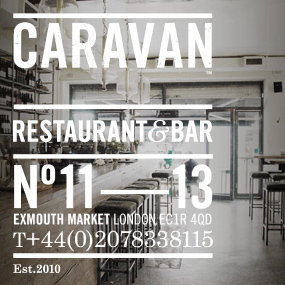I start this blog on a Friday night in mid April and I’ve not long pulled into the homestead at Waiohiki after a long long drive to and back from Auckland. The sky is clear and it’s nippy. I’ve lit the chimera under the lean-to in preparation for a Mokai Whanau Ora debrief with Mane when he arrives from his waananga. His hapu is currently reviving their weaving of korowai. He’s just learned that he’s going to become a granddad and so he’s been supporting Jenny, his lady, in creating a cloak to welcome their mokopuna.
I love this time of the year especially in the gloaming, when we gather around the outdoor fire of an evening and enjoy the juxtaposition of the rising chill and the radiant warmth. It’s been a full-on week and today was no exception. I left Waiohiki at 5.00am this morning for a meeting in Auckland with officials from the Crime Prevention Unit (CPU) and Te Ara Tika o Te Whanau Trust. CPU are looking at picking up the funding for the work that Roy and Knockers and their respective teams are doing in Auckland. On one hand governmental officials see the evidence of a difficult and complex job being done well with youth gangs in South Auckland. The Te Ara Tika teams are dealing with about 20 of the 85 youth gangs that Police Intelligence identified nearly three years back. Many of the 85 have faded away, become engaged in the pro-social activities provided by community groups and churches as part of the youth development strategy, or have become subsumed into the larger groups. Those in the 20 that Knockers and Roy are working with tend to be at the harder-to-reach and more difficult-to-deal-with end of the spectrum. It is now apparent, and I believe widely agreed, that a developmental approach is a necessary complement to the suppression-only strategy that previously prevailed when dealing with these groups. There are many drivers to the relative street calm of the present and the cessation of the spiralling tit-for-tat murders that in recent years saw eight young Aucklanders die, violently, and many more experience the living death of prison. The efforts of the Te Ara Tika team are one reason. Hard policing is also a reason. Smart policing is another reason and even more high impact strategy. I think that being prepared to at least engage in dialogue with Roy and Knockers is an example of smart policing. Their work is authentic, it’s indigenous, it’s pragmatic, and it works.

On the other hand Police and departmental officials are having to deal with the uncomfortable political implications of the reality that the particular change agents they are dealing with are real live gang members albeit ‘reformed’ or at least ‘reforming’. How do you figure out who’s true and who’s false, those that say they don’t yet they do? You Police both ways, maintaining surveillance and intelligence gathering on one hand whilst assuming the best and working proactively on the other. For the best part of the last fifteen or so years New Zealand governmental officials have regarded gang members as ‘non-persons’, with all of the resulting Orwellian connotations. It’s been a self-defeating approach, and I reckon that realisation is growing.
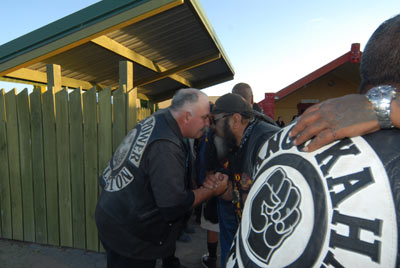
- Denis and Knockers
But, still, it is difficult for bureaucrat or politician to publicly engage with gang members regardless of the efficacy and integrity of each particular effort. It’s a high risk area, and it’s one wherein disappointments will abound. Despite their sincerity in the moment people sometimes make promises or commitments they can’t and don’t keep. It’s not a matter of being ‘let down’ or ‘betrayed’ but simply of acknowledging human frailty and building in as many arrangements and systems to mitigate against failure as is possible. In such circumstances, a kaumatua told me once, just stick to the kaupapa and say your karakia. I need to say this; in my experience pro-social gang leaders are an absolutely essential ingredient during a change process. They may be the catalysts but they won’t be the providers because the new ‘required future state’ is beyond their experience. They are the people who keep the door open to allow ‘indsiders’, people with a mainstream capacity and experience to deliver ‘the goods’.
The P issue is back on the airways big time. Earlier in the month I heard, on National Radio Nine to Noon, a spokesperson from NZ Customs recounting the huge amount of methamphetamine precursor that they’ve intercepted so far this year; mid April 2008, already at last year’s total. International ‘Best Practice’ in borderline security in this regard suggests that at best we’ll just intercept 20% of inbound product. Even if we were doing twice as well as the international standard it is still a scary proposition when we do the math and realise the scale of the likely inflow of P and/or its precursors into NZ. I readily concede that I don’t know what I don’t know in terms of where things are at with P on a national level and the international linkages that are obviously in play. When you’ve taken a public stance like mine you automatically take yourself out of the ‘in the know’ network. Generally all people will talk to me about is how much they hate P and how they aren’t doing it, so it ends up a bit like being the last person to know if someone is bonking your missus. On the other hand, because I’m out there, I see the signs and patterns, and, from time to time people will have an informative word in my ear. I’m not totally naïve but like you I rely pretty much on what Customs, Police and researchers like Dr Chris Wilkins tell us through publications and through the media. Greg O’Connor from the Police Association said on the Nine to Noon programme that the NZ methamphetamine trade is dominated by gangs and he nominated the Hells Angels and the Headhunters as being the big players in New Zealand, with the other gangs being lined up as distribution networks. That may well be the plan on the part of some, and if that’s the case then I guess I’m working in a pretty rocky paddock.
If it is that simple though, that there are two dominant gangs as the primary channel – after all how many individuals would that be? – you’d think the cops would have them so well covered that we would have the matter in hand. Not so apparently. It’s a bit like Bush’s threat to Osama Bin Laden that he can run but can’t hide. It sounded like a statement of fact at the time, considering the USA’s power and reach. But it has proved to be more complex than maybe first anticipated.
There are obviously complex factors at play in the NZ Meth market – the push of aggressive importing and distribution and the pull of continuing demand and preparedness to pay relatively high prices. As a nation we’ve already muscled up on the consequences of being a player in the market – sentences of up to life imprisonment for being a dealer or manufacturer. We’ve also previously invested heavily in clan lab detection and improved border intelligence but still, obviously, that hasn’t done the trick. The lobby demand is to escalate and do more of the same in terms of increased police resources and further legislation around the supply and use of chemical products. All of the ingredients come from abroad so you might expect that we could simply guard the gate and get control at that point. It seems however that we have lost control of our borders. They are porous. One difficulty is that refined meth is a soluble substance so, consequently it can be disguised as part of most liquids we import. Conversely in rock form it can be compacted and can be moulded into articles. The other issue is the precursors, usually in the form of high dosage pseudoephidrine pills, which can be cunningly concealed. There’s also the allegation that fishing boat gangs are swapping paua for P with Asian fishing boat gangs. Crikey, imagine having to monitor and control that. The radio report this morning said that the illicit drug trade in NZ is assessed at being worth $1.3 billion and P is said to constitute 50% of that. It’s a big sum and the stakes accordingly will be high.
If you come from a philosophy in which luck plays a big ingredient then I suppose you might decide just to have a go and try and smuggle in all that you can and concede that you’re going to lose some but win most. That current scenario matches up with the quantum of the Customs seizures so far this year and consequently, if we apply the international ratio, the shitload that gets through and causes grief in our homes and on our streets. I’ve been told that in Welly at the moment the supply is so prevalent that the street price is way down. It’s not an issue that is going to go away fast or even go away at all. I heard Mike Sabin from Methcon Group talking about the issue. He’s an ex copper with experience in meth, and he said that he didn’t see the answer as being policing, but rather harder approaches around demand reduction. In the main I agree although he doesn’t buy in at all to the harm reduction approach that we position ourselves within. I’m still convinced that the directionality we have been pursuing is going in the right way – that is that P is generally positioned as being uncool and unwelcome – but when the big players lure people by the promise of quick wealth we all suffer the impact. The ready availability of low price good quality P can wipe out much hard earned traction and yardage gained in reducing community demand. – communities are made up of individuals and when enough individuals turn back to use it becomes a negative tipping point, for a time, a vortex of increasing demand. I’ve generally argued that demand reduction is the way to go, but damn, the current circumstance calls for an all out all party focus on our borders. Besides the ‘pull’ of demand the ‘push’ of supply is premised on the notion of gaining wealth. There will be those who are getting wealth by dint of export – and by definition these won’t be Hori and Hemi, and they probably get to retain and enjoy the fruits of their wealth. Then, here, there will be those who import and are first level distributors in NZ. They may be visitors or Kiwis and they too may retain their wealth although it wouldn’t pay to be too flashy. But it is at the street, at which point, based on the assessed volumes, a much broader network of distribution must be at play, that the wealth making myth of methamphetamine comes unstuck. The promise of gaining wealth from P is illusory. P-derived wealth may be fleetingly enjoyed but it is not sustainable. Only crap and grief lie that way. My observation is that death, madness or jail are the most likely rewards. The other big lie of the moment is that you can use P recreationally as long as you take a sensible approach. In my view all you do in such a case is swap a fast wick for a slower wick. The only way not to have a problem with P is not to use it. In fact, just don’t have anything to do with it because it seems to bring grief and destruction to whoever it touches.
Whatever the realities, we are bombarded by gang fixated media. Currently on the TV3 schedule is ‘Underbelly’ ‘Gangland’ is on CI, ‘and Ross Kemp on Gangs’ on TV1. There are regular gang related stories on 60 Minutes and Sunday. There was an embittered ‘hard man’ detective grim jawed and fixed eye telling his ‘they’re all scum’ story on the eve of retirement. Mid month 60 Minutes had a story about a former BP chapter president who had turned as a Crown witness in a murder case some years ago and was now whining about his lot in life and wanting a $200,000 pay out. Pam Corkery is currently completing a major documentary on Gangs called Gangs of Auckland. The Wanganui Bill seeking to ban patches is before the House. Steve Chadwick is about to introduce a Bill to ban nominated undesirable persons from downtown Rotorua. Ron Marks is mooting a Bill to outlaw gangs. In 1987, speaking of gangs in New Zealand, Justice Sir Clinton Roper said:
“There is probably no subject in the field of law and order that can provoke more selective and distorted coverage from the media, or more emotive, and often ill-informed, rhetoric from those in authority, than gangs.”
We urgently need to move away from the political hype and rhetoric and start dealing with this matter in a manner based on Muldoon’s ‘genuine humanitarianism and intelligent pragmatism. We need to bring policy makers and decision makers together and collectively discuss the available research and evidence. As I’ve suggested in the blog before, gangs in New Zealand seem to form in times of high employment (due I think to a low wage economy where mum’n’dad both have to work) but the tutae only really hits the fan when the economy lapses. With current indicators are we to see a rerun of the 1980’s in this regard? We have doubled our prison population in the last 20 years. Whey oh! What was the trigger? Could it be those economic policies of the 80’s? If so we need to take advantage of the window of opportunity now before us.
And now it’s the Sunday of ANZAC weekend, with all of the stuff that comes with it, from the maudlin to the genuinely commemorative. In New Zealand ANZAC Day has become a day of nationhood building wherein Maori and Pakeha especially come together albeit over a futile kaupapa. It’s a pity we don’t do so well when there is peace. Mind you, Maori TV is regularly taking over as the national broadcaster on ANZAC Day and really forging tangible cross cultural bonds by providing cross cultural national experiences. My regular ANZAC contribution is to Unity Week, a peculiarly Napier way of marking the ANZAC cause. This year the week started with a Walk for Unity from Pukemokimoki Marae to Otatara.
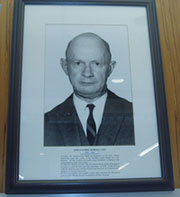
Dr. John Lochiel Robson
Pukemokimoki is a newly erected marae to serve Napier taurahere people’s, the people who come from other places. Otatara is the ancient maunga that shadows Waiohiki. The walk engages maybe 100 or so people, some on horses, some on bikes, and is a simple tradition demonstrating commitment to a cause, in this case, social unity. The walk was followed on the eve of ANZAC Day with the annual Robson Lecture. Dr. John Lochiel Robson was a former Secretary for Justice who with the then Minister of Justice Ralph Hannan saw through the abolition of the death penalty in New Zealand. Robson visited Napier in 1977 in his capacity as the chairman of the New Zealand Social Development Council. Witnessing some of the pro-social activities at a community level that “offered hope during changing times” the Social Development Council advised the Government to establish Napier as a Pilot City. As it turned out the voluminous report of the Social Development Council was destined to become a doorstop for politicians and senior bureaucrats, and the Pilot City notion just too scary for a consistently conservative Napier City Council.
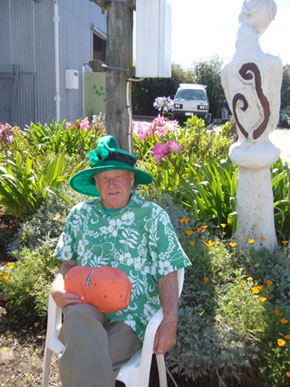
Pat Magill
Nevertheless, led by my ‘kaumatua Pakeha’ Pat Magill, a small but dedicated group has kept the kaupapa alive. Their catch phrase is “Napier builds communities not prisons”. It’s an apposite shibboleth considering that Napier is also the home of the Sensible Sentencing Trust. The Pilot City Trust has established the Robson Collection at the Napier City Council. The Robson Collection, now with over 800 books and a fresh injection of $30,000 from Robson’s daughter as a family memorial, is intended to provide books and related resources around penal policy, criminal justice and social justice. Its key theme is restorative justice. It is a unique resource for scholarship, the sort of scholarship I am advocating as regards the whole gang thing. Anyway each year the Trust holds an annual Robson lecture and this year this was delivered by Governor General Anand Satyanand. It was an erudite and expository tale of our nation’s grapple with the death penalty and it came with the caution that the status quo cannot be assumed in the future and that the argument against capital punishment is ongoing and in need of vigilant defense. He outlined the history of capital punishment here. From 1842 to 1957 there were 83 New Zealanders executed for murder and one for treason. All death penalties were commuted in 1935 and capital punishment was abolished in 1941. However it was reinstated in 1950 although became unworkable from 1957 and was formally abolished in 1962. Here’s the play as described by Anand in the Robson Lecture 2008:
“The issue came to a head with the debate in 1961 on what was to become the Crimes Act of that year. The Bill that Hon Ralph Hanan, as the Minister of Justice in the new Government, and Dr Robson, as Secretary for Justice, placed before Parliament, proposed reinstatement of the death penalty, despite their own personal misgivings.
I have no hesitation in stating my own objection to the death penalty. Academic research shows that its use is often arbitrary and capricious, its deterrent value is highly questionable and that people from minorities often bear a disproportionate proportion of sentences.”
The Government decided that the vote would be a conscience issue and, despite accepting the responsibility for introducing the Bill, Ralph Hanan urged others to campaign against it. I am sure there were many members of the Cabinet and his party who may have taken umbrage at his stand, although they could not have questioned his principles.
In the end, the death penalty was abolished for all but treason when 10 members of the Government voted with the Opposition. What is probably not so widely remembered now is that one of those Government rebels was the late Sir Robert Muldoon, then the relatively newly elected Member of Parliament for Tamaki.
There’s no mucking around there. The GG summed up the issue with a quote from another you would have thought to be a hardliner, Sir Winston Churchill some 80 years ago:
“The mood and temper of the public in regard to the treatment of crime and criminals is one of the most unfailing tests of the civilisation of any country. A calm dispassionate recognition of the rights of the accused and even of the convicted criminal against the State; a constant heart searching by all charged with the duty of punishment; a desire and an eagerness to rehabilitate in the world of industry, those who have paid their due in the hard coinage of punishment; tireless efforts towards the discovery of curative and regenerative processes; unfailing faith that there is a treasure, if only you can find it in the heart of every man; these are the symbols which in the treatment of crime and criminal mark and measure the stored up strength of a nation and are sign and proof of the living virtue in it”.
Goddam I’m hardly in a carddy-tugging club here.
I love having a Governor General who has a brain and is not scared to use it. At the end of his speech he presented Pilot City Awards to 9 recipients for their outstanding contribution to the Napier community. These are the forgotten heroes of community doing simple but important things, voluntary service given unstintingly over a long time. It is such a simple idea, just telling people at the grass roots that their effort has been noticed and that it is appreciated, and it is fitting that the Governor General, constitutionally the most highly ranked person in the country, presented these significant symbols of recognition.
Amongst the recipients was our own Jenny Weichbrodt Brom from the Waiohiki Community Charitable Trust. On ANZAC Day itself, following tradition, we held the annual Unity Dinner at the RSA in honour of the Award recipients. The Unity Dinner is invariably attended by members of the Diplomatic Corps who have been corralled by the irrepressible Pat Magill and his further efforts mean that I am, equally as invariably, the MC. I’ve been telling the same jokes for ten years now. It’s a bit like being the stygian boatman, but, fortified by Alwyn Corban’s generosity in the form of lots of wine we all end up rollicking along and having a great time and I eventually got to lay up my MC Unity Dinner paddles for another year.
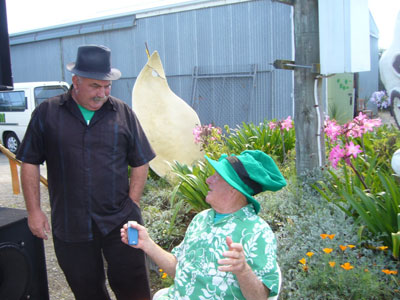
Pat Magill and Denis having a huilli
Well it was a Friday night in mid April when I started this blog and it’s now a Sunday at the turn of May. I’ve had a week in Wellington around our Mokai Whanau Ora research project there. We’ve been constantly probing how we can most effectively deliver primary health care to the Nga Mokai population. We also have a scoping study with a PI gang, the Full Blooded Islanders, and then we need to put some effort into the Hutt Valley. One of the unintended consequences of the location of high and medium security prisons is that families follow inmates to the location. Because of Rimutaka Prison the Hutt has seen the arrival of concentrations of gang related families from outside of the district, and there are some serious issues starting to arise.
On Thursday I was up at Turangi working with Edge Te Whaiti and his Mob whanau at Turangi, helping them spell out a better future. I really enjoy these sessions because as you get into stride and people begin to feel comfortable they start to reveal themselves and their aspirations and it’s all good. On the other hand I’ve got to find an alternative business model to my perpetual travel. Peripatetic may have been good enough for Socrates but the current cost of travel is killing financially and my lifestyle of constant driving, roadside coffee, meat pies and stuff all exercise below the shoulders is doing the same physically. I’ve got to find a smarter way to do my thing. Watch this space.
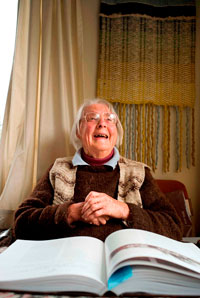
Helen Mason
At lunchtime today we had a little birthday party lunch for Helen Mason. She’s 93. We erected a marquee on the lawn and gathered around her where she sat all rugged up with brightly coloured self-woven shawls. It’s such a privilege having her with us and she says that Waiohiki is a lovely place to get old and make new friends – “it doesn’t always happen when you get old you know” she warns us youngsters. The weather has turned. The first of the bulbs are in flower and the lime trees are groaning under their delicious fruit. I picked a few to have with the fresh fish fillets that Boy dropped off this afternoon. The Warriors have just had a win. There is hope. Arohanui. D







